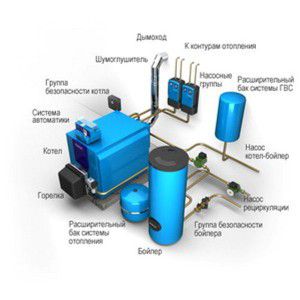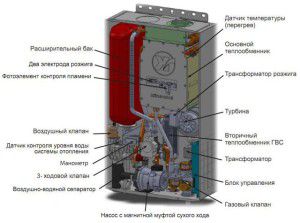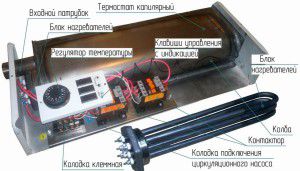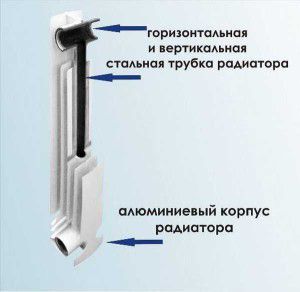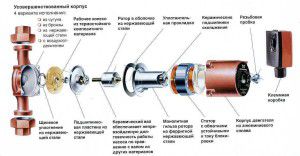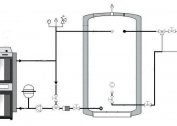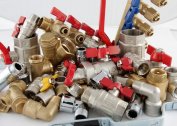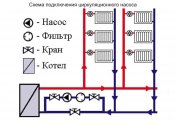The operation of the heating system directly depends on the right components. They must meet not only quality requirements, but also technical and operational ones. What affects the choice of heating elements: radiators, boilers, pumps, pipes? First you need to find out the methodology for building high-quality and reliable heat supply.
The procedure for choosing heating elements
The first step in creating any engineering system is to draw up an engineering project. It includes the calculation of the main parameters, the choice of the pump of the heating systems, boiler, and other elements. This work should be carried out by specialists who know the methodology and calculation procedure.
Heating systems can be of several types - classic water, on electric underfloor heating, convector heating, etc. The most common species is water, as it meets all modern requirements. But to create it, you should choose a gas heating boiler and other necessary equipment.
Consider the procedure for designing the heat supply of a private house, as the most complex:
- Calculation of heat losses in a building, taking into account the climate in the region - minimum temperatures in winter, humidity, etc.
- Determining the optimal piping - single pipe, double pipe or manifold system.
- Calculation of the parameters of the components. This stage will directly affect the choice of heating radiators, boiler, pipes.
- Determination of the most suitable elements based on market offers. This is one of the most important stages, since when choosing pipes for heating, their actual operational qualities can significantly differ from the calculated ones.
Having fulfilled these conditions and observing the requirements for the installation of heat supply, you can create a truly effective heating system for a country cottage. But how does the choice of heating radiators for a private house differ from similar designs for an apartment connected to central heating? Everything is based on initial technological data - pressure in pipes, temperature conditions, etc. But first, you need to consider the most important node of any system - the choice of a boiler for heating a private house.
The circuit must necessarily contain controls - thermostats, programmers. With their help, it will be possible to change the degree of air heating for each room separately.
Choosing a heating boiler
An increase in the temperature of the coolant occurs due to energy conversion. This function is performed by boilers. It is their parameters that largely determine the efficiency of the entire system. Therefore, the choice of an electric boiler for heating or its gas counterpart is a priority when planning an autonomous heat supply.
The first task of the designer is to determine the best option for energy. The main factor is the degree of availability and cost. Based on this, it is possible to choose a boiler for heating a private house of the following types:
- Gas. The most common and economical models. They can work both from the central highway and from bottled gas;
- Solid or liquid fuels. They require the observance of special operating conditions, which include the organization of a place for storing firewood, coal or diesel fuel. Installed only if there is access to cheap energy;
- Electric. They are characterized by small size and optimal efficiency. However, when choosing an electric boiler for heating, it is necessary to take into account the high cost of the energy carrier.
Each of these types has its advantages and disadvantages. But there are several common characteristics that are decisive.
To store bottled gas, it is necessary to equip a separate room with all safety measures - ventilation, a reliable system for switching cylinders, etc.
Boiler power selection
This is a defining parameter indicating how much heat energy the structure will generate in 1 hour. A number of factors influence the choice of heating boiler power - the calculated temperature regime of the system, the heat loss of the house, its area and volume.
There are several ways to determine this parameter. They directly affect the selection parameters of a gas heating boiler or its analogue:
- By area and volume of the house. On average, 1 kW of heat energy is required to heat air for 10 m². But this is only if the external walls of the house have good thermal insulation;
- Performing a complex calculation of the heat loss of a building. This will take into account not only the parameters for choosing the power of the heating boiler, but also the degree of load on the system.
For the reserve, experts recommend adding 15-20% to the received boiler capacity figure. This is necessary for the possible expansion of heating or the installation of more productive radiators and batteries.
Over time, the efficiency of any boiler will fall. Therefore, to maintain the initial characteristics, it is necessary to periodically flush the heat exchanger and check the operation of the control elements.
Type of boiler installation
Currently, the selection of a gas heating boiler is carried out not only taking into account its technical parameters, but also operational. The consumer attaches great importance to the method of its installation.
Gas models most often have a wall-mounted installation method. This minimizes the occupied space and does not affect the choice of heating boiler power. However, for powerful types of heaters, only a wall-mounted installation is used. This is due to the large weight of the heat exchanger and additional equipment - expansion tank, control unit, circulation pumps, etc.
Regardless of the installation method, the material of the walls and floors where the boiler is planned to be installed must be made non-combustible.
Features of a design and a complete set of a copper
The design of the boiler and the additional components provided for in it influence the choice of a boiler for heating a private house.
Before purchasing a model, you need to check the configuration and its functionality. In order not to make a choice of a circulation pump for heating, you can stop at the boiler where this component is already installed. It is additionally recommended to check for the following items:
- Expansion tank security group. It is often difficult to make a choice of an expansion tank for a heating system, since it can be of considerable size and have a complex wiring diagram;
- The presence of a second circuit for domestic hot water;
- The capabilities of the control unit are a programmer, data transfer about the state of the system to the user using the GSM module, etc.
These are the main characteristics that directly affect the choice of an electric boiler for heat supply or its solid fuel or gas counterpart.
Before purchasing a boiler, it is recommended to check the remoteness of the service services for products of a particular brand. This will help to quickly resolve the situation with a breakdown or improper operation of the equipment.
The choice of radiators
After choosing the optimal boiler model, it is necessary to determine the following heating components - batteries and radiators. They are designed to transfer thermal energy from the coolant to the air in the room. When choosing heating radiators, it is recommended that you first study the range on the market.
How does the choice of heating radiator for an apartment differ from that for autonomous heating? First of all, with the system parameters. Therefore, first you need to study the current characteristics of heating and according to them, purchase the optimal battery model:
- Pressure rating. The determining parameter for any type of heating, except gravitational. In autonomous systems, this indicator is usually 2.5-3 atm. In centralized jumps up to 5-6 atm are possible;
- Heat dissipation. When choosing heating radiators for a private house or apartment, the rated thermal power of the device should be taken into account. It is measured in watts. Depending on the design, the manufacturer gives this indicator for the 1st section or the entire battery as a whole;
- Temperature limits. Almost all models are designed for thermal effects up to + 110 ° C;
- Connection method. When choosing a heating radiator for an apartment, they most often stop on models with side connection. However, in addition to this, there is a lower and upper way to connect the device to the system.
In addition to the above operational parameters, heat supply batteries have a number of other, unique characteristics. They affect the installation and further operation of the device.
Before choosing a heating radiator for an apartment, you must definitely check its equipment. It may include fasteners, plugs for pipes, as well as a mechanical temperature regulator.
Radiator Material
Manufacturers offer many models that differ not only in external data, but also in the material of manufacture. Each type of radiator is designed for operation in certain conditions. Therefore, in order to choose the optimal heating battery for a private house, it is necessary to study its properties, depending on the material of manufacture.
Until recently, most apartment buildings were equipped only with cast-iron batteries. However, they have a number of disadvantages; therefore, fundamentally new types of heating devices were developed:
- Aluminum. They consist of supply and return pipes along which the coolant flows. To transfer thermal energy, they are connected to the sections. The best models are made not by welding, but by casting;
- Bimetallic. They are distinguished by the presence of steel or copper pipes, which provide optimal operational characteristics - pressure;
- Steel. For the most part, these are panel batteries, consisting of a pipeline, a steel casing and heat transfer plates that provide heat transfer. They are characterized by low cost and ease of connection.
For autonomous heating, most often they choose aluminum or bimetal heating radiators. For central heating, the installation of cast iron or high-quality bimetallic ones is recommended. This is due to possible water hammer, characteristic of this type of heating.
Each radiator or battery model must have a certificate of quality or compliance. The buyer has the right to request a copy of this document.
Selection of a circulation pump for heating
For closed heating systems, a circulation pump is mandatory. The expansion of the coolant provokes the beginning of its movement along the highways. However, in most cases, this is not enough for normal operation. Therefore, it is necessary to choose a heating pump.
To choose a circulation pump for heating, you should know its main technical characteristics:
- Performance. Determines the amount of coolant passing through the device in 1 hour;
- Head value. Indicates the degree of overcoming the hydraulic resistance of pipelines and radiators in the heating system;
- Power consumption - Tue
Often, little time is devoted to choosing a pump for the heating system. This is a mistake, since the thermal distribution of pipes and radiators depends on its parameters. Therefore, in addition to the technical conditions, experts recommend carefully studying the functionality of each model:
- Wet or dry rotor. In the first case, the cost will be much lower, but the noise level will increase;
- Control devices. It is best to choose heating circulating pumps with electronic work control units. They will automatically change the speed of rotation of the impeller, depending on external factors - temperature and pressure.
You should also consider the choice of coolant for heating, antifreezes have a significantly higher density than water. Therefore, the pump power should be 25-30% more than the calculated one.
When installing 2 or more pumps, their normal operation should be ensured, and in particular, synchronous rotation of the blades. Otherwise, water hammer will occur in the system.
The choice of pipes for heating
What is the basis for choosing polypropylene pipes for heating? This material has become truly versatile. But for all its merits, it has a number of disadvantages, which you must know about.
In the process of choosing pipes for heating, attention should be paid to their operational characteristics. Thus, steel structures are much more reliable and can carry significant loads without damage. But they are destroyed by the oxidation process. That is why often buyers opt for polypropylene heating pipes.
They have a number of specific parameters that must be taken into account:
- Maximum exposure temperature. The highest value for pipes made of compressed polyethylene + 95 ° C. On average, this indicator does not exceed + 90 ° C;
- Pressure values. They depend on the choice of the cross-section of the pipes for heating - the larger the diameter, the thicker the wall. Typically, the maximum pressure should not exceed 15 atm;
- Type of reinforcing layer. To reduce the cost of construction, aluminum foil is used for this. Expensive models are reinforced with fiberglass.
At the first stage, it is necessary to calculate the system parameters. Based on this, the choice of the cross section of the pipes for heating is made. It determines the total volume of the coolant, the choice of its type, as well as the optimal speed.
When choosing a coolant, it is necessary to take into account its possible effect on the material of pipe manufacturing. This is especially true for steel lines.
In addition to the above components of the heat supply system, you need to pay attention to the choice of expansion tank, safety group, shutoff control valves.
In the video material, you can familiarize yourself with the parameters for choosing polypropylene pipes for heating:
